#book biennial
Text

MABB 2024: Touching/Reading, Curated by Astra Papachristodoulou, MABB – Malmö Artists' Book Biennial, Victoriateatern, Malmö, May 24-26, 2024
Participating artists: Hartmut Abendschein, Stephen Emmerson, Lara Felsing, Caroline Harris, Briony Hughes, Imri Sandström, Greg Thomas, Astra Papachristodoulou, Marama Salsano, Vik Shirley, Karenjit Sandhu and more
(on the way of Vik Shirley)
#graphic design#typography#art#poetry#exhibition#visual writing#book#cover#astra papachristodoulou#Hartmut Abendschein#stephen emmerson#lara felsing#caroline harris#briony hughes#imri sandström#greg thomas#marama salsano#vik shirley#karenjit sandhu#malmö artists' book biennial#2020s
13 notes
·
View notes
Text
Checking Libby constantly to see if my hold came in will make it arrive faster, yes?
#book nerd problems#booklr#Currently in the middle of my irregularly scheduled biennial romance binge#I need the next book and I need it NOW#I’m first in line and it is TAUNTING me#last romance binge was some het historical series a few years ago#this time we are doing kj Charles! I did not mean for this to happen lol#idk it kind of scratches the fanfic itch I think#bec posts
23 notes
·
View notes
Text
Similarly, grafting a shoot from the LDP Petunia hybrida onto a stock of the cold-requiring biennial henbane (Hyoscyamus niger) caused the latter to flower under long days, even though it was nonvernalized (Figure 20.18).


"Plant Physiology and Development" int'l 6e - Taiz, L., Zeiger, E., Møller, I.M., Murphy, A.
#book quotes#plant physiology and development#nonfiction#textbook#ldp#long day plant#grafting#flowering#biennial#petunia hybrida#henbane#hyoscyamus niger#vernalization
9 notes
·
View notes
Text

Pacific heights pink. 🌞🌸🐈(mixed media collage on canvas)🎨
#kids room decor#art commisions#playground#playgroup#kids art#childrens book illustration#jean michel basquiat#basquiat#cy twombly#keith haring#jean dubuffet#guggenheim#whitney biennial#momamuseum#lacmamuseum#pacific heights#lost cats#lost cat#swings#swingset#neo expressionism#neo pop art#folk art painting#naive art#outsider art#art brut#collage artwork#collage art#willem de kooning#david hockney
2 notes
·
View notes
Text

Shio Kusaka: Volume 3; 2014, 2015, 2016. Blum & Poe “Published in conjunction with the exhibition Shio Kusaka (July 2 — August 20, 2016) held at Blum & Poe Los Angeles.
This catalogue is the first in an ongoing series of catalogues documenting a selection of Kusaka’s artworks, inspired by Japanese pottery reference books. This first volume focuses on works from 2014–2016. Shio Kusaka lives and works in Los Angeles. Her work was included in the 2014 Whitney Biennial, Whitney Museum of American Art, New York, and has been exhibited throughout the world.”
Arcana Books
505 notes
·
View notes
Text
Utopian Realism, a speech by Bruce Sterling
*I never posted any lecture of mine on Tumblr, even though Tumblr would seem to have plenty of elbow-room for hour-long, learned, European public lectures (with many lecture slides).
*Might as well give that a try and see what happens.
From the Technology Biennial in Turin, Italy, April 02024.
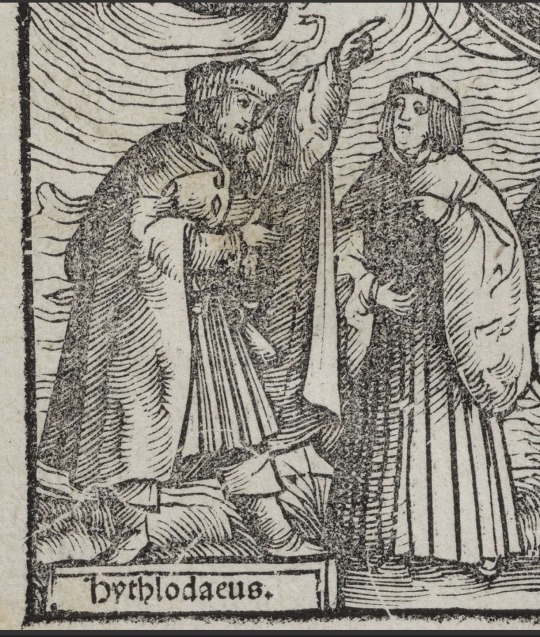
Thanks for coming to see me. As Loredana Lipperini just pointed out, I am Bruce Sterling, here to deliver my speech on the theme of “realistic Utopia” — the public Utopia, and the private Utopia.
This first slide would be the hero of my remarks today, because he’s the world’s biggest expert on Utopia. He’s called “Raphael Hythlodaeus.” In the Italian editions of the book “Utopia,” he’s “Raffaello Itlodeo.”
Here’s a picture of Raffaello personally meeting Sir Thomas
More, and Sir Thomas More’s friend and host, Peter Gillis, in the year 1515.

The book was published 500 years ago in the Latin language. The author was Sir Thomas More — but Thomas More was a lawyer. He didn’t plan to be a novelist. In the book, he claims that he’s simply writing down the testimony of Raphael Hythlodaeus. The source for the book is allegedly Raphael (according to Thomas).
So, the novel “Utopia” was a kind of a hoax or a joke that Thomas More invented — while he was on vacation.
This book project happened because More had to leave England on official business. He had to leave his private home, and his beloved family, and take part in public life, as a diplomat in the service of the king of England.
So, Thomas More had to travel, and go meet some Spanish officials in the city of Bruges on the European continent. So he left England, and he dutifully journeyed to Bruges. But — after some weeks of diplomatic struggle — he realized that the negotiations were going nowhere. His negotiations were a hoax and a joke, because the king of England and the king of Spain were quarreling. They had no intention of ever reaching an agreement.
So Thomas More had to spend six long months of his life in Europe pretending to be a diplomat and a lawyer, to satisfy reasons of state. He could not achieve anything useful or practical on that mission.
So, More was a bit upset by this situation. He left the city of Bruges, where nothing was happening. He went to Antwerp instead, because he had a friend there. His friend was a fellow scholar named Peter Gillis. Peter Gillis was an Antwerp city official. He was in government, and he was quite well-to-do, a very well-connected guy. So, he could play host to Sir Thomas More. Thomas More was welcome to stay in his private house for no money, and to eat the family’s food at no charge, and just relax as an honored house guest, for several months.
So, Thomas More and Peter Gillis are in this private home, avoiding actual work. They enjoy many free-wheeling, private, intellectual discussions, which are all about law, and justice, and business, and economics, and politics, and the general state of the world.
These two intellectuals agree that the state of the world is pretty terrible. Clearly the real world is quite bad, it’s not a Utopia at all. In fact the first part of the book “Utopia” is pretty much all dystopia. It’s about how bad things are in Europe, and it’s rather realistic too — these are grim assessments.
So, Thomas More and Peter Gillis, while discussing the world together, decide to invent this wandering scholar named Raphael Hythlodaeus. The wise and learned Raphael can speak Latin and Greek, just like they do — but Raphael has been to a country where everything works.
Peter Gillis even invents a Utopian alphabet, and he writes some poetry in the language of Utopia — just to demonstrate that he can play this fun Utopian game with his guest Thomas More.
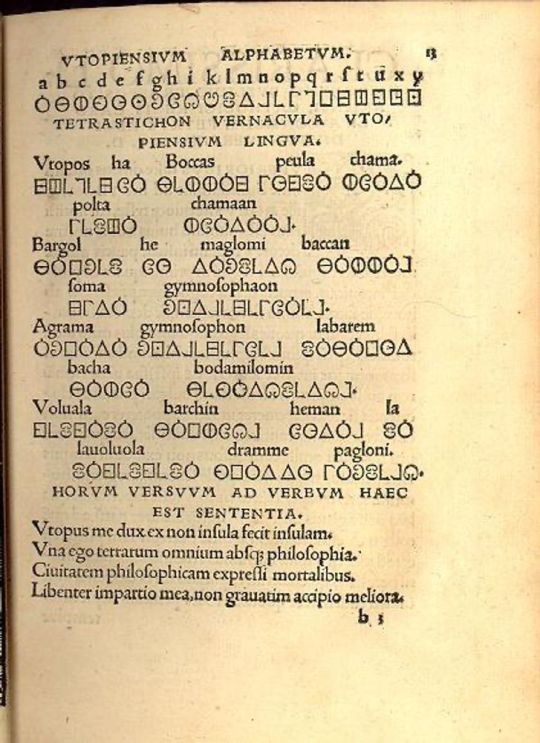
Peter Gillis is willing to cooperate. He even pretends to personally introduce Thomas More to Raphael Hythlodaeus.
In the book, Raphael appears, and he starts talking. He recites the entire story of Utopia. Raphael speaks the book “Utopia,” aloud. It’s 30,000 words of text, so Raphael recites this book in one long afternoon. It’s a three and a half hour lecture, and Thomas More writes it all down.
However, it’s somehow not boring. It’s a brilliant, world-class lecture, because Raphael Hythlodaeus is quite an amazing guy. Raphael doesn’t look rich or famous. Basically, he looks like a sailor. He’s got a long beard, and he’s kind of weatherbeaten. He’s a long-haired wanderer in beat-up old clothes.
He says that he’s from Portugal — he’s a native of Portugal — but somehow he’s been to Persia, and Ceylon, and spent rather a lot of time in Belgium. He’s been to Brazil. He knows England very well. Raphael Hythlodaeus knows the Archbishop of Canterbury personally.
If you read the book carefully, it turns out that Raphael Hythlodaeus left Portugal — he went to Brazil to explore the new world — and he crossed South America, somehow. Then Raphael crossed the Pacific Ocean, discovering several new countries that nobody else ever heard of. Somehow, after visiting Ceylon, he returned back to Portugal.
So Raphael Hythlodaeus has circled the entire world — several years before Ferdinand Magellan and his fleet tried to do the same thing. Raphael is the first guy to ever travel around the world.
Why?
Why did he do it?
Well, basically, it’s because he’s a tourist.
He derives no political or economic benefit from all this wandering. He just wanders — he tours. He says that he had a lot of money once, but he gave all the money away — to members of his family, and to friends. He refuses to ever serve in any government. He understands law. He understands economics. He’s a super knowledgeable guy. But he never takes part in public politics, because he says that it’s slavery. There’s no reason for him to stop travelling and ever do that work.
Raphael Hythlodaeus is basically a dropout hippie backpacker. He’s a refusenik. He despises power. He despises wealth. He’s rigorously
anti-materialistic. He’s an intellectual dissident.
He’s not a pilgrim of any religious faction. He doesn’t engage in any trade while he travels. He has no career. He’s not a lawyer. He’s not a banker. He’s not a patriot — he’s never going back to Portugal. He cut his ties with the homeland. He’s cosmopolitan.
Any town in the world is good enough for him. Antwerp is just fine. He’s happy to be in Antwerp, although he has no reason to be there. He’s just in Antwerp while talking to Sir Thomas More. He has no wife. He has no mistress. He has no children, no grandchildren. He has no duties. He never has to change clothes.
Every day — he says — he just does whatever he likes.
He just does whatever he likes!
Raphael Hythlodaeus is the most utopian figure in the book “Utopia.” He’s a one-man Utopia. He’s a personal Utopia — because he makes a utopia all by himself, just for himself.
This struggle between the private, personal Utopia, and the political, public Utopia, is present from the beginning of the book “Utopia.”
In the book, Raphael says that he lived with the Utopians for five years. He knows everything there is to know about them. He studied them very closely. He knows the Utopian language, he knows their alphabet, their history, their military, their judiciary, their economic system, their justice system. He knows how they educate the youth. How they raise crops, what they eat, how they dress, the transportation system. Everything.
He just comprehensively knows everything about that society — every driving force that matters, every aspect that makes a country a country.
So Thomas More and Peter Gillis, they make lunch for him. They just invite this world traveller over to the private house they share. They offer him something to eat.
After they eat together, Raphael is quite happy to tell them everything there is to know about the Utopian system. For no pay — no reward. He doesn’t want any credit in the book, either. He just delivers Utopia to them, in one comprehensive talk.
Then Raphael Hythlodaeus just disappears. He has complete existential freedom. He just drifts around the planet like the wind. He’s a Utopian tourist. He’s a traveling one-man show. He’s like an exile on planet Earth.
He’s a fictional character and the book “Utopia” is a fictional book, but Thomas More was a very real person. More was inventing this Utopia game, and making it up in detail, mostly to amuse his host Peter Gillis, who was feeding him, and sheltering him.
But Thomas More ran out of vacation time. He was on vacation in Antwerp, but he had to go back to England. He had to return to his private house, and to resume his public career as a working lawyer.
He had no more time ever to write any fiction. Thomas More never wrote fiction again. He wrote a lot of government tracts. He wrote sermons and legal opinions. No more fiction, though.
After about a year in England, More bundled up all his Utopia papers. He put the game aside, and he sent all the paperwork to Peter Gillis. He said: you know, Peter, I have no leisure time to mess with this game anymore. Why don’t you see if you can do something with it? You participated, so just do anything you want with this Utopia project. Maybe Erasmus can help you.
That would be Desiderio Erasmus of Rotterdam, the very famous European scholar. Erasmus did help — he helped Peter Gillis, and together they published the world’s first edition of Utopia.

That’s the book. You can see that Erasmus is the editor. Erasmus has added plenty of his own witty epigrams to the text. Erasmus knows this book is innovative and strange, and he’s trying to increase sales by including some Erasmus content.
The book was a private joke for Thomas More — because it was only published in Europe. This is him, by the way.

This is the author of Utopia, when he had achieved high rank in the English government. Thomas More doesn’t care about novelists — there was no such profession, there were no copyrights. He’s an intellectual scholar who became a public politician. He works for the English government — the royal court in London. He’s prosperous. He builds a grand private mansion for himself and his family. This is the house:
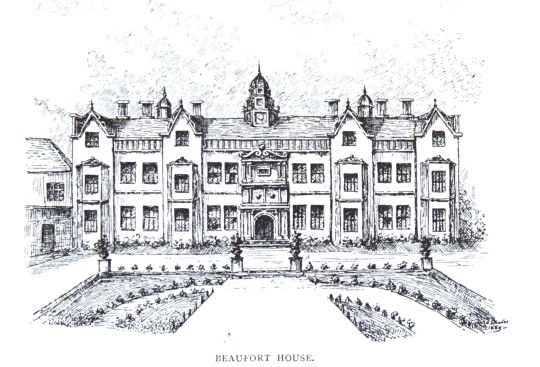
His book Utopia is not published in England — not while More was alive. The English knew practically nothing about this novel, written in Latin, in Europe, by their Lord Chancellor, rather discreetly.
Here’s Thomas More in his private life.
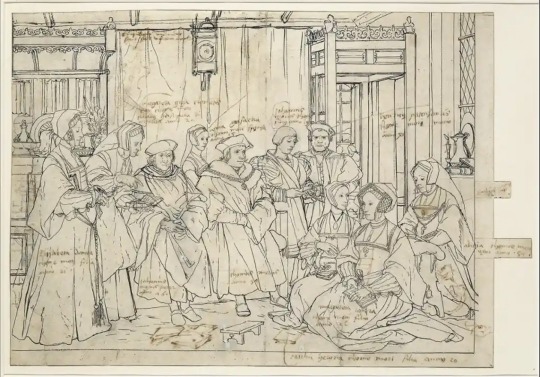
This a sketch of a portrait that he’s working on, together with a hired artist. More has a gold chain around his neck because he’s become the Chancellor of England. However, his private family life is of great concern to him. Thomas More is writing many careful hand notes on this sketch, so that the artist can paint it properly.
This is a portrait of Thomas More’s entire household. Not just himself — all his relatives, and also his household retainers, everyone under his roof. They’re all gathered in his house, to be recorded for posterity.
It’s really quite a nice private house. It’s got a very high-tech clock on the wall. If you look at it: flower bouquets, vases, curtains….
All the women in this portrait have books. Because they’re all literate. Thomas More has educated every woman in his house. They understand Latin. They can write Greek. They know astronomy, music, mathematics. They’re some of the most highly educated women in the world. He educated them privately. Inside the house. Women could not go to school, but he pulled in the best scholars and he had them give lessons to his wife and his daughters. And retainers. And anybody who’s listening.
More’s private house is a kind of Utopian University.
This is the eventual painting which was made from the sketch.
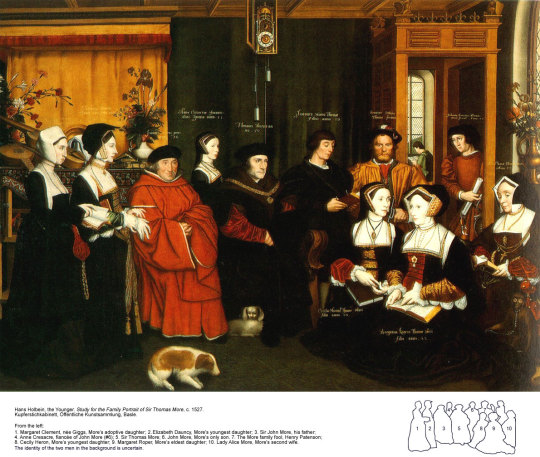
The fellow in red, that’s Thomas More’s father.
Dad was also a lawyer, and he was also involved in politics. But, he got involved in a serious controversy. He was imprisoned in the Tower of London.
That was dad’s experience. He had to go inside the Tower of London for a month. A terrible place. A dungeon. Political opponents of the English regime, they’re tortured and sometimes murdered in the Tower of London. A very sinister place.
One month of that Tower of London prison experience was plenty for dad. He retired from public life immediately. He never sought political power again. He just went back to the house with Thomas More and the very educated girls. There was plenty to do in there. It’s a private house, but look at it, it’s nice. There are carpets. Dogs. Nice clothes. They have some messengers, like a scholar in the back, writing some mail. It’s so civilized that it’s like a different world.
Things go well for a while — but then the author of “Utopia” himself gets into some very serious and realistic political trouble. Because the king of England is divorcing his wife, who is a Spanish princess. He’s removing the Kingdom on England from the Catholic church. It’s basically a Brexit situation.
He’s seceding from Christendom, and declaring himself the spiritual head of the Church of England.
Thomas More does not approve of this. He’s very pro-European, he’s a diplomat. He knows the idea is terrible. There will be nothing but trouble from it.
He tries to be diplomatic with the King. He gets into all kinds of legal arguments. This is no use. King Henry the Eighth, he’s determined to marry six different women. It’s realpolitik. It’s a political crisis. The king will not back down.
More leaves power, he tries to escape the dismal mess and go on vacation. He just goes back to his private house. Like his dad.
I’m not in the government, he declares. I want nothing to do with government. I don’t seek power. I don’t want wealth.
But his private life cannot protect him. The regime insists that he has to sign a public declaration that the King has moral authority over the Pope. He’s just required to sign this — to collaborate. He refuses. It’s a very long, painful controversy. He doesn’t want to sign. He’s fighting on ethical principle. I’m a private citizen. I’m in my own house. I want nothing to do with politics. You can’t make me sign public documents against my will.
That struggle doesn’t end well. Here is a painting of the author of Utopia getting arrested for treason against the state.

In the foreground of the painting, his daughter is clinging to him. Don’t take Dad from our house! Then in the background of the painting, Thomas More is getting publicly executed. His head is chopped off with an axe on a block.
The details here are interesting. The realism of what really happened to this utopian author. They cut his head off his body in public.
Then, one of the daughters managed to collect his body. She didn’t get the head. The head was boiled in a pot, in order to preserve it. Then it was painted with tar. His head was painted with pitch as a kind of preservative.
Then the head of the author of “Utopia” got stuck on a long spike on the London Bridge.
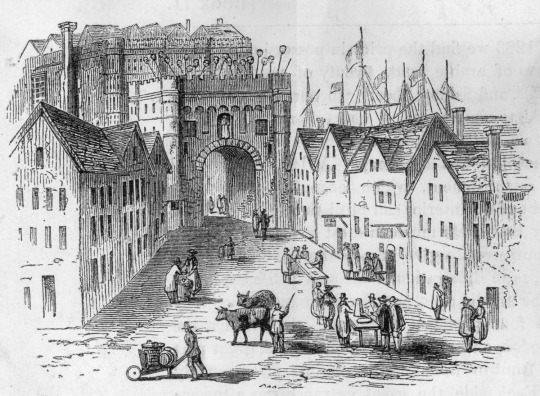
This was customary justice in England at the time. This definitely happened to Thomas More. In historical fact, his head was placed on one of those spikes on the top of the arched bridge, in much the same way that you can see here in this everyday London woodcut.
After a month of public exposure, of the author’s head on a spike, the legend says that one of his other daughters somehow managed to collect his head. Somehow, she retrieved the head off the spike, even though the boiled, tarred head was supposed to be thrown into the river Thames. That was the custom with the heads of traitors.
She had no house, because her father was a traitor and the house had been confiscated. So she’s homeless, but she’s clever and well educated. She speaks Greek, speaks Latin, she understands astronomy, music, mathematics. She’s a cosmopolitan woman from a private house, and somehow she manages to persuade the “Keeper of the Heads” to convey her father’s severed head.
She carries it away from the public shame of the London Bridge. It’s not clear what happened to the head. There are a number of various stories about what she did with it afterwards.
To my mind, this is the ultimate “realist utopian” image. If somebody says the word “Utopia” to you, you should think of an adult woman smuggling the severed head of her father away from an execution.
That’s what it’s like. You write “Utopia” and your grieving daughter somehow steals your chopped-off head, and smuggles your head away in a bag.
Now we forget about Thomas More for the rest of the presentation — because he’s dead.
Meanwhile, there’s Italy. Yes, Italy!
In Italy, nobody much cares about More’s head being cut off, but they are reading his book “Utopia.” Because Italians — it turns out they love Utopia. The book’s editor, Erasmus, is very popular in Italy — the University of Torino gives Erasmus a degree in theology. So Italians eagerly read Thomas More’s book in Latin, and they understand that this is speculative political fiction. It’s quite an interesting thing to do.
There’s even a kind of fantascienza genre of utopian writing — not in England, but in Italy.
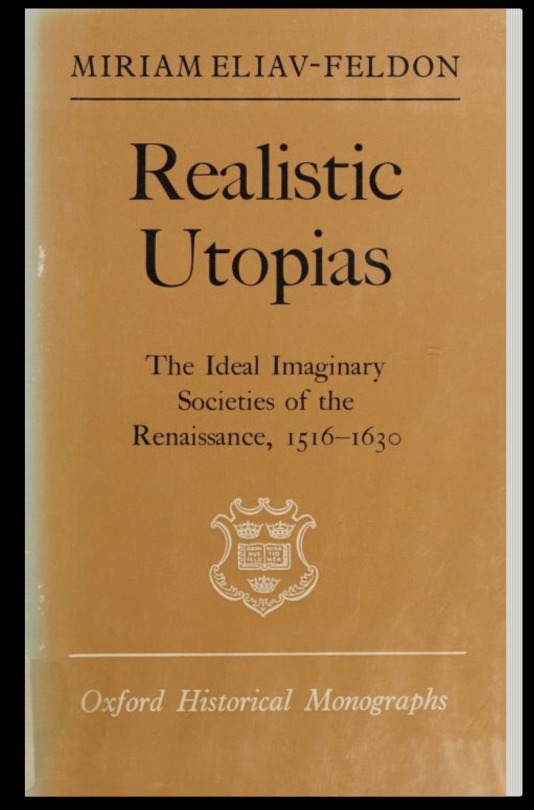
There’s a whole set of utopias written by various authors.
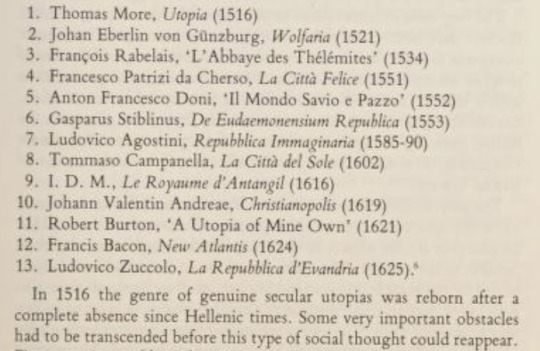
Most of those authors aren’t English — English people know your head comes off, you don’t want to mess with it — but there are all these other guys writing Utopias.
There’s Tommaso Campanella — his book is still in print. You could go buy it today. It’s kind of interesting.
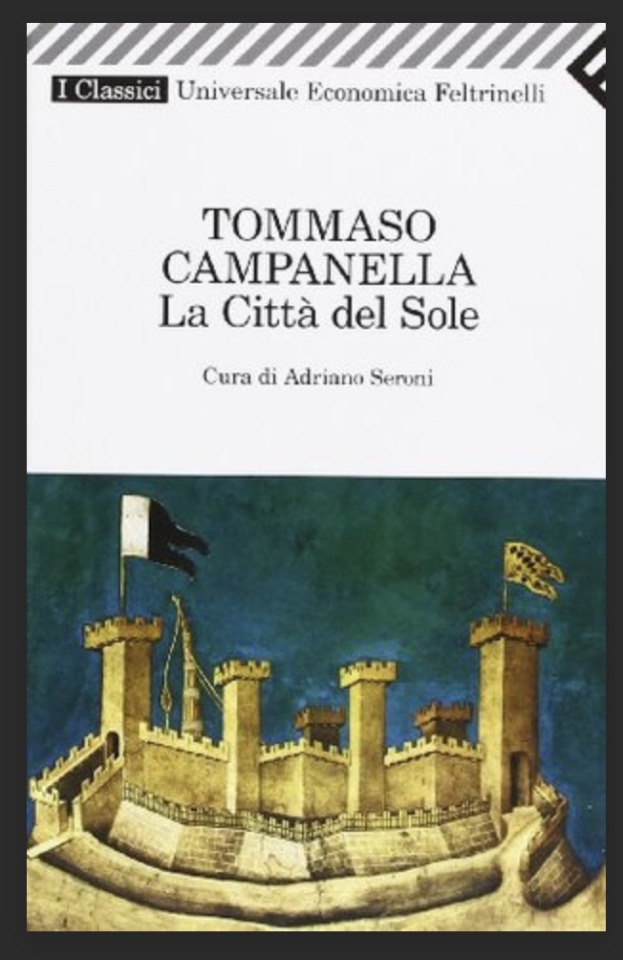
There’s Ludovivo Agostini. He still has some interest to scholars. The Imaginary Republic.

What a good idea.
This is Anton Francesco Doni.
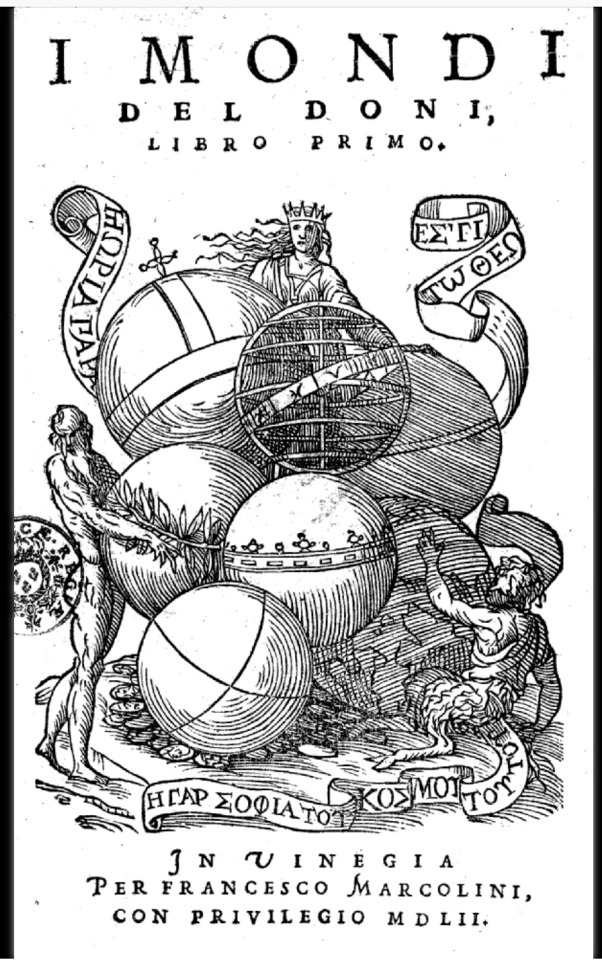
He’s probably the weirdest author of historic Utopias.
He wrote one that’s rather like science fiction, a weird book meant to be funny and entertaining. Doni’s quite an odd character.
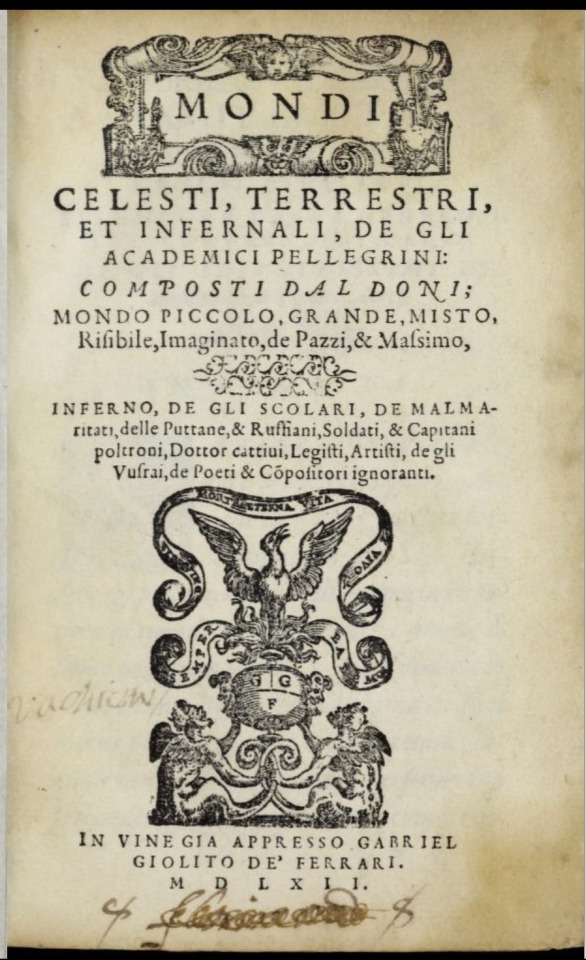
Here’s an Italian political anthology where many Italian political writers are describing the real politics of real places. In the end, they just throw in Thomas More’s Utopia. Why not? Does it even matter if it’s an ‘imaginary country’? It’s about the principles of understanding countries. How do you describe them? How do you explain how they work?
That’s what matters about utopias. That’s the realistic reason to do it.
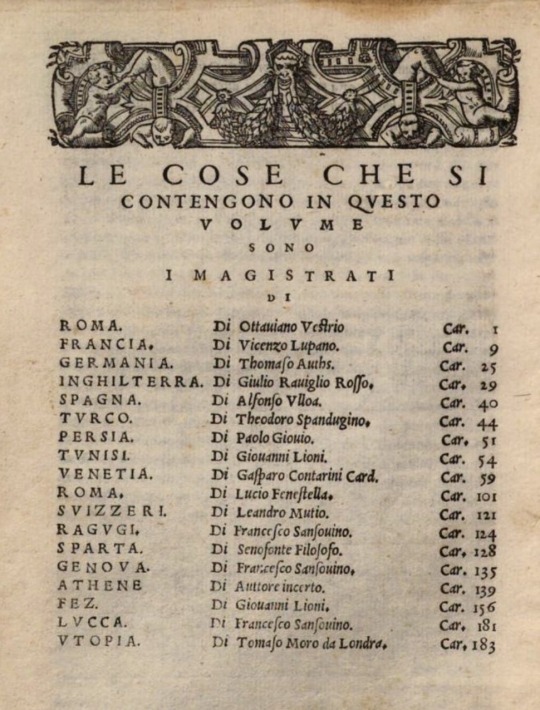
Now we come to a realist political writer who understands Thomas More. He likes to quote Thomas More. He’s Catholic like Thomas More. He’s a Latin scholar — although he writes in Italian.
Unlike Thomas More, he’s extremely realistic. This is Giovanni Botero.
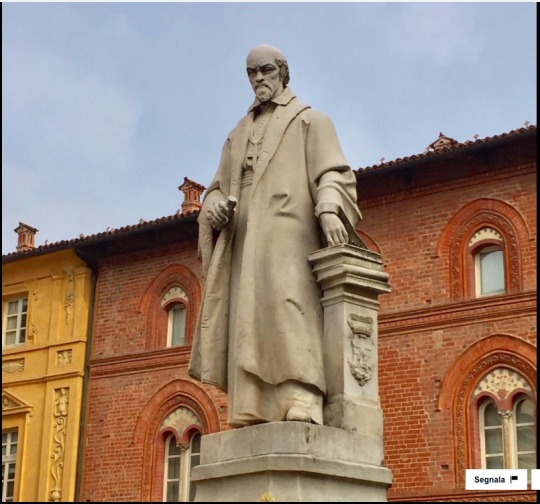
Or, rather, a well-deserved statue of him. Botero wrote a book which was a utopian manifesto, but for the city of Torino.
Yes, Torino was a planned project with a political theory. Here’s his street here in town — it’s over in the Quadrilatero — the oldest part of the city. The “Via Giovanni Botero.”
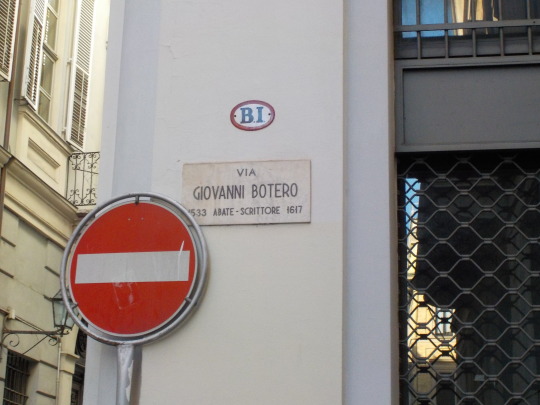
Here’s his book, which is all about politics, and it has an
afterword. It’s a political book about government, including a work of analysis about cities.
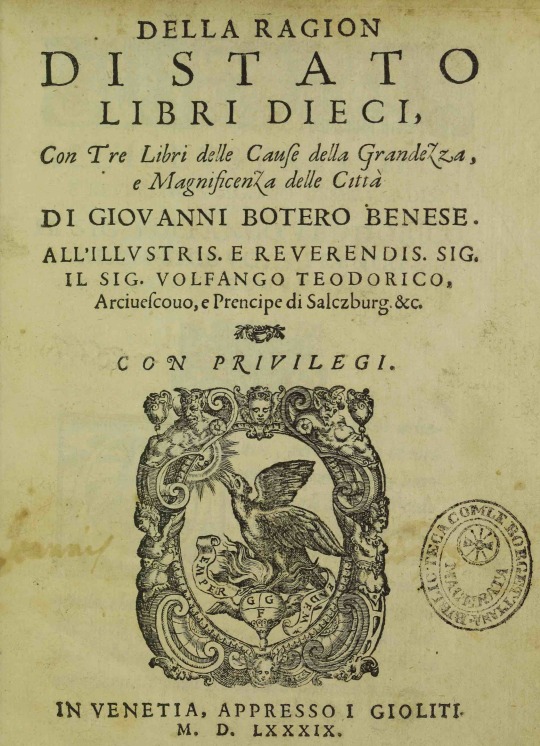
How do you build a grand and magnificent city?
There are a lot of cities all around the world — how do you make one grand and magnificent? What if Torino was magnificent and grand?
How would you make a small town in Piedmont magnificent and grand? What policy would you pursue? How could rulers take policy steps to achieve “grand magnificence”?
Clearly this seems like a utopian idea. Why would Torino ever be grand? This is what Torino looked like when Botero was writing about it.
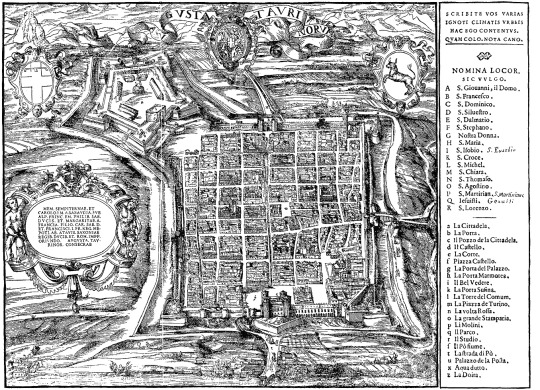
He is urging the Dukes of Savoy to make this little village magnificent and grand, but it’s not grand, it’s not magnificent. It’s just a small, typical Piedmontese town with a huge fort in the upper left-hand corner.
As Botero points out in his manifesto, no city in Piedmont has ever been grand. Torino is a modest city, like Asti, like Bra, like Cherasco. Botero himself is from Piedmont. He knows the history of the region. He is frank and honest about it, he’s a realist. There’s just never been a big city in Piedmont. No grand city like Genoa, Venice, Rome… This region of Italy had never had any grand magnificent town.
Why not? Well, Giovanni Botero is very keen on studying history, and geography, and law, and economics, and demographics, industrial policy and geopolitics, and other disciplines that did not have names in his own time. However, he somehow absorbed the political lesson of Utopia about how to imagine the town as a whole, functional place. How to get it to exist, how to get it to work.
Botero has learned to think in a utopian way that is realistic. He tells his readers that determined people can really do it. He doesn’t merely preach that Torino will somehow be grand. Instead, he says: what are the general principles of cities becoming grand?
This realistic map is Torino as a kind of Cherasco. It’s charming, in
Cherasco. I’ve been to the historic town of Cherasco here in Piedmont, and it’s very nice, actually. I always enjoy it there in Cherasco.
Cherasco is the “world capital of snails.” If you’ve ever been to Cherasco, you would know the “Festa della Lumaca.” The Lumache… they’re great. They’re Slow Food, those snails. If you like “slow food” those snails are really, really slow.
It’s fabulous, I love them, and that is Torino without Giovanni Botero. Without the grand plans of Giovanno Botero, Torino is basically Cherasco.
Unfortunately I don’t have time here to discuss Botero’s ideas in detail, but I promise you, if you read his book, you will understand Torino much, much better.
He makes a very practical case for grandeur and magnificence. You don’t do it on a whim. There are political reasons to do it.
Botero says, to maintain a living city, you need three things. First, you need cheap bread. Not just bread, but enough that it’s cheap economically. Plenty to eat, always there.
Second, you need peace, because if the city is under siege all the time, and people are getting killed, and it’s some mere struggle for survival, that won’t allow the town to function. It just won’t be able to work.
Third, you need justice — so that the population doesn’t cut each
other’s throats. There’s no civil war in the streets. People can get on with their productive business.
So, Botero says that peace, bread and justice are the basic necessities. But — they’re very difficult to maintain. Often, they will fail. Then the city will suffer a setback.
But — if the city is grand and magnificent — people will return. You will attract people with a spirited imagination who can appreciate
the grandeur and the magnificence. That is the quality of urban people that you actually want. That’s why you do it.
So that was Botero’s realistic utopian plan. Unlike Thomas More, Botero did not get killed. He could have been killed, because life in the Ducal Court of Savoy was very dangerous, but he was allowed to retire with dignity here in Torino. When he died in Torino, he had the pleasure of seeing that indeed the town was becoming quite grand rather quickly.
So, that’s what a realistic Utopia can look like as a political success on an urban scale. The public utopia — but what about the private Utopia?
Botero shows us how to do it as a politician — and kind of get away with your grand plans — but what about our friend Raphael Hythlodaeus?
Raphael doesn’t want to do any public politics. He just wants to do as he himself pleases, every day. Does he also have a possible victory condition?
I actually think he does — the homemade private Utopia. Just one fellow. Like him. One wandering sailor with no great wealth and rather modest resources.
If he has determination, he can lead a surprisingly different life on private principles. Even in the 20th century.
So, this is the American artist Alexander Calder. A very inventive fellow. He spent a lot of time in Europe. Alexander Calder was a sailor for quite a while, much like Raphael Hythlodaeus. Kind of dressed in rags, not much money, a wandering dropout guy with one pair of shoes. A Paris bohemian artist who spent some time in Montparnasse.
In this picture, Alexander Calder decides to build his private Dream Home.

Out of this wreckage here. A big dead building.
Luckily he has Mrs Calder to help him, so he’s not completely alone. Mrs. Calder here — “Louisa James Calder” — she happens to be a cultured Boston aristocrat who speaks excellent French and has a lot of elite social contacts.

Her family said that she was “looking for a different way of life,” and when she married him, boy did she ever get one.
So here she is, making some French bread while Calder’s reading some art book. If you’re a design critic you would notice this is a very peculiar kitchen. Very peculiar indeed.
Here’s a photograph of his other house in France.

Calder probably made at least half the furniture in this room. His wife made the rugs. She was helping out, she liked to make carpets.

This is his studio. People said it looked like an airplane had crashed into the building. Calder had some unique personal filing system. He did not regard this as as a disturbed environment. This was his idea of efficiency. He was a very efficient and effective artist. He made 20,000 artworks in these studios over a 50-year career.
There are eyewitness accounts of him, grabbing his tools, grabbing pieces of stuff, and never misplacing anything. Nothing ever got lost in there. It’s otherworldly, very private, very weird and very personal.

This is a Calder handmade bread toaster. Why? Why would you need to make a personal toaster? You could just buy a toaster — and this one’s obviously dangerous. It’s not even made of industrial components — it’s made from scrap of no commercial value, made of bits of wood, leftover pieces of stone, and wire.
I’ve looked at it a lot. I’ve tried to figure out why Calder would do it. He built at least five of these. Five completely different self-invented unique toasters.
Why?
Why not just go buy the toaster at a store? Well — he very much wants to hand-make a toaster. He wants his toaster as a radically different toaster, the one that belongs to him. This is a “utopian device” in the sense of something that seems visionary, farfetched and silly.
It’s just not practical, not realistic — but it’s practical and realistic for him. Calder tended to make art out of objects that the world had abandoned. Like the Turinese “Arte Povera” method — find junk, and dress it up, and re-format it.
He had a different value system. To him this is is not junk. To him, this is a struggle for understanding.

Here he’s making forks. Why?
Why would anyone go to the trouble to make forks? Especially out of cheap wire, because these are wire forks that he hammered flat. So that wire would behave more like forks.
I think what happened here — Calder liked hand tools. People called him a machine artist, because he made sculptures that moved, and sometimes had motors. But he only had two machines in his studio — a drill and a grinder.
He had no other machines. He preferred making personal things with his hands. Expressive tools — in his own hands.
So he’s sitting and he’s eating with a fork — and he realizes this is a
tool in my hand. This fork is a tool in my hand. Why isn’t it my personal fork? Why doesn’t this fork have more of my own values?
Right? It’s a Utopian Fork! It’s my personal very different Fork. I don’t care how long it takes me to make it. I want it to express! I want to hold it in my hand and eat with it.
It’s not for sale. These are not commodities. They are what they are — artifacts from a very different value system.
He was a successful artist — at the end of his life, very successful. Calder was quite a wealthy man, and after he died, then his heirs were very wealthy indeed — by artistic standards.
His home in France is an art center now. You can go there and make art in his studio.

These may not quite look like utopian objects, because they’re so personal. But it’s probably what a handmade personal Utopia actually has to look like. You have to dig down to the original basic principles.
It has the freedom of Raphael Hythlodaeus. It’s intelligent. It’s erudite. It’s well traveled, cosmopolitan. But the rules of the world do not apply to it. They just don’t.
It’s “Utopia fai-da-te.” It’s a house as Utopia, it’s private, it’s homemade.
You could you do this yourself, personally, after you left the hall of the speech here. Great — I go back to the house, I make my own Fork. Right? You could, it’s not impossible. You could do it. He did it. He’s proving to himself that he can do it. It’s just — that it’s very rare.
Why? Why do you need a personal Utopia? Why does that matter to you? Where is the benefit? Why not just buy the same toaster that the guy has next door?
Raphael Hythlodaeus could go back to Portugal. He could get a job. He could get married. He could work for the Duke. The private Utopia — it’s like one man trying to to do everything that the world can do for him.
Also, Calder’s alone in the countryside. He’s not in the city. He doesn’t have any critics watching him, as he makes unrealistic forks.
What about the city, the public utopia, the City full of other people? What about — for instance — the Utopian city of Torino? The grand, magnificent Turinese realistic utopia?
What can be said about it, here and now?
Well, I have some passing ideas on that subject — mostly because I have read Giovanni Botero.
Botero wants to use grand magnificence to attract people into the town. His strategy is about a town that can survive. Not because it’s a town that is really good at snails, but because it is a grand city with glamour and charisma. That’s why why you want to do it.
Also, it’s pretty clear that to me that this — realistically — is what Torino has been doing for much of my lifetime. Torino was a city that suffered economic setbacks in the 1970s, and was having some basic Botero-style trouble with the food and the justice system and so forth.
But — when the heavy manufacturing failed — it has been slowly trending toward art, design and especially tourism. Heritage tourism. The Baroque architecture in Turin has not been this sexy in 300 years. Botero’s grandeur is an international tourist draw. It’s becoming like a Turinese Florence.
You might have to visit it over a long period to see this urban
transformation, but it’s realistically happening. It doesn’t look or feel like a utopian project — because it’s basically about attracting tourists.
However, tourists have utopian aspects. Mostly because they’re struggling to escape from their real lives. They’re dying from too much realism — the harsh reality of their crushing lives. They want to experience something that feels different and refreshing, if only for two weeks.
A basic Turinese problem here is that Torino is progressive, but a heritage tourist industry, which is very attractive to tourists, has no avant-garde. Their stifling interest in your past holds you back. You can’t do “futuristic heritage industry.” Why? Because you can’t move forward into the past.
Supposedly.
Supposedly, you can’t show anybody any “new past.” You can only show them old, decayed remnants from the past that have always been here, and have somehow survived to the present day. You can’t show them an exciting, innovative past that no one has ever seen before.
However — if you wanted to be realistic and utopian — you might actually do this.
While Giovanni Botero was alive and writing about how to build Torino, this was Torino’s most grand and magnificent building.

Everybody in Torino knew this building. It was the Mole Antonelliana of medieval Turin. This is the “Tower of St Gregory,” the tallest tower in Turin.
Giovanni Botero saw this Tower every day. Everybody in Torino saw this Tower every day. If he was alive, among us in this room, he’d be horrified to realize it was gone. It would be a tragic loss. A Torino with no “Civic Tower”? A dystopian disaster! Scarcely a real Torino at all.
If the Civic Tower was still actually here, it would attract endless tourists. It happened to be demolished in the year 1801, because Napoleon knocked it down. There were efforts to rebuild it, but these efforts failed due to lack of economic realism.
However, if you did restore the Tower of Saint Gregory from utopian impulse, you could offer it to tourists as an exciting new heritage building. You could do that, because the city of Torino has excellent archives, and there are all kinds of records about exactly what this Tower looked like during the 500 years that it towered over Torino.
The Turinese are very skilled at restoring partially damaged buildings. They do that all the time. So why not just restore the entire building? Why not be bold and inventive, and utopian and realistic, and make a completely vanished building come back to life?
This grand and magnificent Tower has been gone since 1801, but now it’s back again. It was history, but now it exists again. It’s not illegal to restore vanished buildings. Physically, it wouldn’t even be that expensive to do it — certainly not by the standards of many other ambitious Turinese urban projects.
It’s mere custom, and the habit of mind, that makes you think that old buildings can’t suddenly spring back to life out of the records. Of course they can.
When I started this speech, I said that Raphael Hythlodaeus was a tourist. He went to see Utopia. He took a lot of notes. He never settled in Utopia. He never married a Utopian woman. He never emigrated to Utopia. He didn’t ask for Utopian citizenship.
He just witnessed Utopia and then he lectured about it.
But there is no “Utopia for tourists.”
If you’ve ever been a tourist, you know it’s actually a rather dystopian user experience. The experience is more or less horrible.
Maybe you want to go to another country — because you’re a tourist. You want to experience a different way of life. You want refreshment, you want escape from your reality.
Well, first you go to the airport — where you’re treated as a terrorist. They literally go through your luggage, your shoes.
Then you reach the border and there you’re treated as a clandestino, or maybe a smuggler. They’re extremely suspicious and hostile. Those are not even realistic efforts. They don’t really serve the cause of law enforcement or of civil order. They’re actually systems which are built for intimidation. They’re there to make you feel worse and to be sorry that you ever decided to travel. They’re in place to hurt your feelings and discourage you.
Then, as a tourist — when you’re a tourist in a foreign city — everyone hates you. Attempts are made to tell you to enjoy yourself, to eat the expensive food and spend your money on nice clothes, but there’s very little there that’s for your actual benefit.
That’s all just basically advertisements. That’s the business model. The local people want nothing you might offer as a human being, they simply want your cash. They don’t want you around. And for good reasons. When masses of tourists arrive in your city — when you’re a really successful tourist city — it’s like the city dies wherever they step.
There doesn’t seem to be any civilized way to deal with them. Even if you’re a tourist, you hate the other tourists.
These people — tourists — are the people within your city who realistically need a Utopia. You don’t need a Utopia. They need the Utopia.
If you’re a native of the city, you’re used to the city. You cherish the city. You’re a patriot. You want to live in the city with your memories, your urban experiences, that make it your place, your city.
You don’t want your City to be a Utopia — not even your own backyard! Here in Turin, if someone said, “Make the San Donato district a Utopia” — Everyone in San Donato would immediately say: “Make Campidoglio do it!”
“Make Cit Turin do it! Not us!” Then they would force San Salvario to become the Utopia, because San Salvario is full of foreigners and they never know what to say.
So if you want to build a utopia -- realistically -- you should build one for tourists.
I’m not sure what that would look like. I could speculate about it a little. I think it would be mostly psychological.
It would be like a a wellness retreat. Some kind of spa. I’m thinking some large Turinese building like a derelict factory. Empty — like the Cavallerizza. Or the former “OGR,” the dead train repair yard. Some derelict space turned into a big utopian box.
It should be soundproofed. It should be airtight — like a gambling casino, where no clocks are visible. There are no windows. The air should be filtered because the air in Torino is terrible. There are hundreds of tourists inside this utopian box. Maybe thousands of tourists in there.
It costs nothing to get into the box. It’s a free public amenity in Turin — built just for them, entirely for them.
But to get into this Utopia they have to remove their phones. They have to remove their clothing. They have no wallets, no purses, no purchasing power.
No money. No identity. No passports. They have to remove themselves, that’s the key to it. They’re free — free not to be who they are.
What’s in there? Nothing. There’s nothing to buy. There are no thrill rides, no multilingual experiences.
I think the tourists themselves should probably disappear. They should be wearing special effect suits, like this.

Special tourist holiday suits that cause people to vanish. They blend into whatever is projected on the walls. I think that projection is probably Torino — dream-like utopian images of Torino.
Not the realistic Torino, with Turinese people in it, but a tourist utopian Torino, grand, magnificent, unearthly — and there’s no plot. Nothing happens there. Nothing bothers you. Everything is under gentle surveillance. You’re a utopian tourist. You’re just peacefully drifting around through this foreign space, and you’re also foreign. You could sleep in there if you want.
Most tourists, they don’t really want thrills or excitement. They are tourists to escape the everyday trauma of their miserable lives. They’re not moving toward the attractions. They’re running away from their dystopian suffering. So they should be in a utopia, and they should vanish. Nobody has to look at them. They’re engrossed in Utopia. Eventually they come out then maybe they spend some money before they go back to their private lives elsewhere.
Okay, now I’ll close with a few personal words. I’ve spent a lot of time in Torino myself — sometimes on a tourist visa. But I have never once been “on vacation” in Torino.
Never. I never had a job here. I don’t labor here. I’m not a voter. I don’t participate politically. I don’t stare at the tourist attractions. I don’t even eat the tourist food.
For my wife and myself, Torino is our city of romance. We had known about one other for rather a long time, but Torino is where we first met.
It seemed utopian to think that we might ever be together. Because there were all kinds of good, sensible reasons why people from Texas and Serbia should never get married. For the two of us to be a husband and wife, it seemed farfetched and absurd, and yet, there was something realistic about it. Because it was Torino. We were really together there. It was true, it was real life.
A romance is a remote possibility — like mere wishful thinking, an empty dream — that can suddenly spring into real life. You can never plan for that to happen. But when it does happen, you become very aware of it.
It’s not that I went to Torino, or that she went to Torino — rather that we went to Torino. We do participate in the life of the city, but we’re just not Turinese. I can’t claim that we have any conventional purpose here at all. Nothing political, nothing economic, nothing diplomatic. Nothing that fits into a business plan or a government form.
Mostly we’re in Torino because in Torino we are us. In Torino we became us. A rather mysterious and utopian quality for a city to have. So Torino is not Utopia, but we do appreciate your kindness and your hospitality. So, thank you for that, and that concludes my speech.
Thank you for your attention.
128 notes
·
View notes
Text
Oenothera biennis flowers on its second year of life, being a biennial, as indicated in the name.
However mine apparently did not read the rule book because they sprouted this spring and are already growing tall stalks, just as their parent plant did right before blooming.
The internet gives no indication that this is A Thing That Can Happen. My only guess is that I've misidentified the species, however the plants definitely LOOK exactly like O. biennis; I have no idea what other species would even BE here that has a close enough appearance to O. biennis.
Is there a population with an annual lifecycle that isn't documented? Do biennial plants do this sometimes? Weird as hell
256 notes
·
View notes
Photo

Book Pavilion, III Biennial of Decorative Arts, Monza, Fortunato Depero, 1927
42 notes
·
View notes
Text



September 18, 2024
262/366 Days of Growth
Some images from the book event I went in Sao Paulo (Bienal do Livro - Book Biennial Sao Paulo), which is like an enormous book fair.
I bought books there and walked until feeling pain all over my body, but it was fun. My husband got some tickets for us to visit a friend who is a fantasy author.
The vacation is being good for do things we had to delay here and there (sleep, for example).
#studyblr#study#study blog#daily life#dailymotivation#study motivation#studying#productivity#book fair#book#bookshelf#bookworm#books and reading#booklr#bienal do livro
9 notes
·
View notes
Text
Unicornmachine AO3 Masterlist
Okay I've wanted to make this post forever so here we go~
For starters, absolutely none of these are safe for work, they are all so very explicit, I'm sorry.
Fiolee
OMG did this pairing possess me (and continues to...) there are so many stories I’ve written for them I’m making a read more break here.
Love in the Moonlight
Summary: Fionna the Human drops by the Candy Palace for the Biennial Gumball Ball, but she doesn't get much dancing done as she's approached by Marshall Lee the Vampire King. She hasn't seen him in years, since she's gone off on rumors searching for a new Enchiridion in Aaa and he's been spending his time in the Nightosphere, and wow. He's just as she remembered, down to the incessant flirting. Let's see if he can make good on any of these promises.
First off, okay, let me just say this was my OG Fiolee fic and the first fanfic I had written in well over a decade. I started out like many authors writing fanfics as a teenager but stopped when I started working on original works. I published three OC books IRL and really enjoyed writing them but there's something about writing fanfics that is just... so much more fun to me. I rewatched Adventure Time and remembered how much I always loved the Fiolee pairing, so I tried to look them up on AO3 to read about them... AND THERE WAS HARDLY ANYTHING!
Oh no, I told myself, I will just write one little fanfic for fun, for old times sake! WHAT A LIE THAT TURNED OUT TO BE.
I had no idea what I was getting myself into when I wrote Love in the Moonlight, but I'm so happy I did.
The Deal
Summary: In a moment of desperation Fionna makes a deal with Marshall Lee the Vampire King.
Oh man... The concept of this fic was so undoing to me, a human making a deal with a vampire? A little of their blood in exchange for some necessary help? UGH!!!
A Challenge Between Friends
Summary: In an attempt to win a challenge to scare Fionna, Marshall Lee accidentally takes things too far while exploring a dungeon and loses his grip on himself.
My friend and I were literally feral coming up with the concept of this. I mean... sexy vampire? Dungeon sex? Marshall sucking the red coloring out of Fionna's bra? WHO SITS AROUND AND DISCUSSES THIS STUFF WITH THEIR FRIENDS?! Me, apparently!
Fionna Campbell: Vampire Hunter
Summary: After 1000 years of peace vampire attacks are popping up and it seems a new vampire is preying on the land. Who better to cleanse the land of this new evil than the original vampire hunter, Marshall Lee the Vampire King. He’ll just need some human bait.
This fic... OMG this fic, this fic, this fic... This is probably my favorite story I've ever written. It is so self-indulgent to me and I honestly had so much fun writing it.
The Star
Summary: Fionna travels through the multiverse, to the universe where the vampires won on a mission to retrieve Simone a new crown. While traveling through the wreckage of this strange, new Aaa she meets The Star.
All I could think while watching the Fionna and Cake episode about Marceline becoming The Star was... WHAT IF WE FLIPPED THIS? AND MARSHALL WAS THE STAR? AND HE CAPTURES FIONNA?! hahahahahaha!!!
There are also multiple one-shots and smaller stories on my AO3 featuring this pairing. Love in the Moonlight has a follow up that is still in progress that is linked to the original fic. One may argue this is simply too much Fiolee porn for one person to write. The only thing I can think is... it's never enough.
Huntbunny
Ahhh! This pairing is so cute! I love the idea of Fionna and Hunter Wizard. I haven't written NEARLY enough of these two, but I have more stories in progress.
The Magic Flower
Summary: Fionna runs into trouble deep in a forest on a mission to retrieve a magic flower. Thankfully, someone finds her and helps her out...
So, this story came from a friend sending me some very explicit Huntbunny fanart from the X artist Yakza_draw. I wrote a story to go with the art and sent it to the artist as a thank you for her making such a wonderful work. She ended up becoming a very dear friend of mine, so this fic will always have a special place in my heart.
The Traveling Fountain
Summary: A string of misfortunes leads to Fionna being knocked unconscious and Cake trapped in a moving cave inside an enchanted forest. Hopefully her new friend can help her find a way to rescue her sister and get to the bottom of where all this rotten luck is coming from.
9 notes
·
View notes
Text
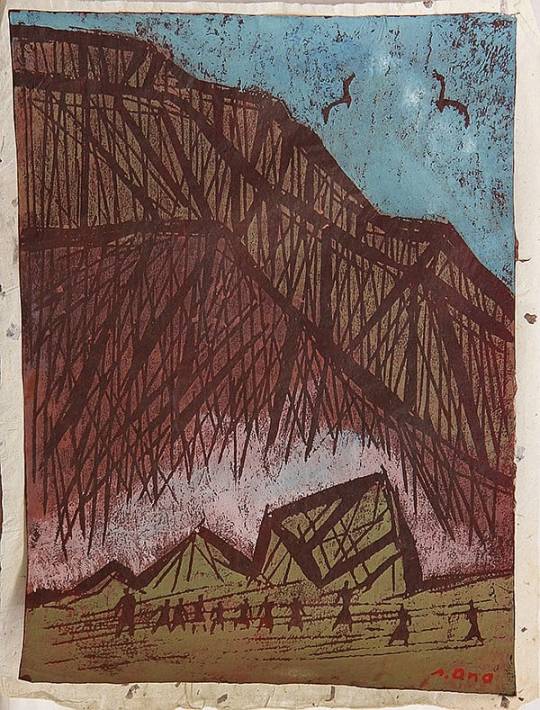
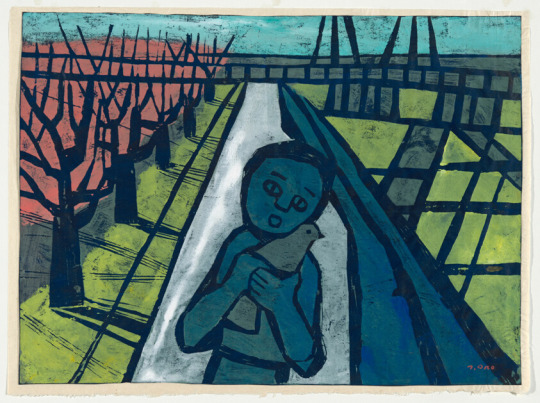






Ono Tadashige is a leading representative of Japanese postwar printmaking. His art style was strongly influenced by the movement of social-critical prints that was wide-spread in the 1920s and 1930s in Germany, Russia, China and also in Japan as the 'proletarian and farmers art movement'.
Ono Tadashige was born on January 19, 1909, in Tokyo, Japan. He had studied art at the Hongo Art Institute from 1924 until 1927. In 1941 Ono Tadashige graduated from the department of Japanese and Chinese languages of Hosei University Higher Normal School. At a young age he became an active member of the sosaku hanga and the proletarian art movement.
After the end of the Pacific War the artist's International career began. His prints were accepted for several of the International Print Biennials - 1957 in Tokyo and 1961 in Moscow. Ono Tadashige became a visiting professor at a couple of Japanese universities - Tokyo University of Fine Arts, Aichi University of Fine Arts, Hiroshima University, and Utsunomiya University.
The artist published several books on modern Japanese hanga and one book on Chinese prints.
Ono died October 17, 1990.
Prints - Style and Technique
The early prints made by the artist, meaning before world war II, were deeply rooted in the social-critical movement of German expressionism and the art trend dominating in Russia and among critical, intellectual circles in China (Luxun).
At the same time, there was a similar art movement in Japan, led and nurtured by Kanae Yamamoto (1882-1946), who is considered the founding father of the sosaku hanga movement. When Kanae Yamamoto tried to return from Europe to Japan in 1916, while world war I was raging, he stopped in Moscow for several weeks, and experienced the beginning of the Russian revolution. Back in Japan, Kanae Yamamoto pursued utopian socialist ideas by founding such projects like "Japan Children's Free Painting Society" or the "Farmers' Art Movement".
This was the background which had formed the character and art style of Ono Tadashige. After the end of the Pacific War, Ono Tadashige's enthusiasm for the ideas of proletarian revolution had lessened, but the way he saw his environment had not changed much.
His favorite subjects were town views of the industrialized areas - factories with tall chimneys, canals with tug-boats. The artist does not show a beautified Japan, but the Japan of industrialized cities.
Ono Tadashige's technique and style is congruent with his subjects. The colors used, are somber with much use of dark brown and black. And while a printmaker usually starts to print the light colors and then adds or overprints the dark colors, Ono Tadashige did it the other way round.
He began the printing process by darkening the paper with black ink. The light and white colors added on top of the black background gave them a kind of opaque effect, which is so typical for the art prints of Ono Tadashige.

18 notes
·
View notes
Photo










Chiharu Shiota’s gorgeous installations are just one part of her engaging exhibition, Signs of Life, at Templon in NYC. The installations lead to other rooms of smaller sculptures as well as paintings.
From the press release-
After a foundation degree in painting at Seika University in Kyoto, Chiharu Shiota chose to pursue her artistic studies in Berlin, focusing on performance. Her practice soon shifted towards site-specific installations. She skilfully weaves knotted threads to create fantastical scenes combining salvaged window frames, a piano, suitcases, books and used clothes. Bordering on drawing and sculpture, her fabulous ephemeral, immersive installations have become her signature. Since her impressive installation for the Japanese Pavilion at the Venice Bienniale in 2015, she has become one of the key figures on the international art scene and is regularly invited to show her work at museums worldwide.
In a hyper-connected world, Chiharu Shiota’s new exhibition questions the notion of the “web”, a living organism similar to the structures that make up the universe or the neurons our brains are built on. Created on-site over two weeks, a large-scale installation made of red threads symbolizes this permanent connection of information, collective memory and the world’s knowledge which cuts across cultures and continents. At the heart of the work are two arms, her own, placed on the ground. They are cast in bronze, palms facing up to the sky. “I always thought that if death took my body, I wouldn’t exist anymore,” explains the artist. “I’m now convinced that my spirit will continue to exist because there is more to me than a body. My consciousness is connected to everything around me and my art unfolds by way of people’s memory.”
The installation is followed by a series of sculptures. Enfolded at the centre of each one, as though frozen in place by the intertwined threads, are objects from daily life. “I feel that the objects we possess are like a third skin,” she says. “We accumulate these things and transpose our presence and our memory to them.” Often obsolete, weighed down by impenetrable histories, these objects — old suitcases, stained dolls, miniature pieces of furniture and tiny bottles — represent the treasures offered up by memory, to be seen but not touched.
This exhibition closes 3/9/23.
#chiharu shiota#templon#templon gallery#templon gallery nyc#art installation#nyc art shows#installation art#sculpture#collage#mixed media#painting#drawing#memory#web#art#art shows#chelsea art galleries
64 notes
·
View notes
Text
Because annual and biennial plants undergo whole plant senescence following fruit and seed production, both are termed monocarpic because they reproduce only once (Figure 22.26).


"Plant Physiology and Development" int'l 6e - Taiz, L., Zeiger, E., Møller, I.M., Murphy, A.
#book quotes#plant physiology and development#nonfiction#textbook#annual#biennial#senescence#fruit#seeds#monocarpic#plant reproduction#soybean#glycine max
1 note
·
View note
Text
Biennial book fair tomorrow with friends + brother!! Excited!! I got a pass from being a registered author ^^
29 notes
·
View notes
Text

EDNA O'BRIEN (1930-Died July 27th 2024.at 93).Irish novelist, memoirist, playwright, poet and short-story writer. Elected to Aosdána by her fellow artists, she was honoured with the title Saoi in 2015 and the biennial David Cohen Prize in 2019, whilst France made her a Commandeur de l'Ordre des Arts et des Lettres in 2021.
O'Brien's works often revolve around the inner feelings of women, and their problems in relating to men, and to society as a whole.Her first novel, The Country Girls (1960), is often credited with breaking silence on sexual matters and social issues during a repressive period in Ireland following the Second World War. The book was banned, burned and denounced from the pulpit.Faber and Faber published her memoir, Country Girl, in 2012.Edna O'Brien - Wikipedia
#Edna O'Brien#Irish Novelists#Irish Playwrights#Novelists#Playwrights#Notable Deaths in July 2024#Notable Deaths in 2024
2 notes
·
View notes
Text
Today's bi book of the day is This Spells Disaster by Tori Anne Martin!

Fake dating gets a magical twist in this enchanting bi4bi sapphic rom-com where a witch worries that the real feelings brewing between her and her crush were sparked by an accidental love potion and the only way out of the disastrous spell is a healthy dose of the truth—drink up, witches.
Potion maker and self-proclaimed "messy witch" Morgan Greenwood is sure she was hexed at birth. Not only did she drunkenly offer to fake date the woman of her dreams during the biennial New England Witches' festival, but Rory Sandler, spellcasting champion and brilliant elemental witch--for reasons known only to the Goddess--accepted. It's like every good luck spell Morgan ever cast came through at once, and it doesn't take a crystal ball to predict this charade will end with a broken heart.
Or is the magic between them real? As Morgan and Rory prepare to fool everyone at the festival, their relationship starts to feel a whole lot less fake--right until Morgan realizes she might have screwed up the common relaxation potion she made for Rory and given her a love potion instead, breaking one of the most sacred Witch Council Laws.
To fulfill her promise to Rory, Morgan must somehow keep playing pretend while under the watchful eyes of Rory's family and legion of fans. But to break the love potion, she'll also have to prove how incompatible she and Rory really are. For a screwup like her, ruining their relationship should be easy--except every day, Morgan is becoming more bewitched by Rory herself.
GR link
#Bi book of the day#bi4bi books#bisexual books#bi books#lgbtq books#queer books#bi rep#sapphic books#lgbt books#booklr#bisexual romance#bisexual representation#bi visibility week#Bisexual visibility week
17 notes
·
View notes